🎹 Crop Classification
Classification of crops based on various parameters for their easer understanding.
Crop
- “A group of cultivated plants those are grown commercially on a large scale”.
- Cultivated plants or agriculture produce, such as grain, vegetables, or fruit, considered as a group.
- The basic principles of crop production are the ways and means for the better management of soil, plants and environments to obtain ecologically maximum returns per unit area for years.
Crops Classification
💡 Why crop classification is important?
- To get acquainted with crops
- To know the growing season of the crop
- To understand the requirement of soil and water of different crops
- To know the adaptability of crops
- To know the growing habit of crops
- To know the economic produce of the crop plant and its use
- Overall to know the actual condition required for the cultivation of the plant
Basis for Classifying the Crops
- Botanical Classification (Scientific Classification)
- Agronomic Classification (Economic Use)
- Life cycle (Ontogeny)
- Seasons
- Climatic Condition
- Root depth
- Mode of pollinations
- CO2 fixation
- Special Purpose
Based on Botanical Classification
Botanical classification is based upon similarity of plant parts and flower structure.
- This is the most important way of classification because it determines to what extent the plants are relatives.
- Field crops belong to the
spermatophyte, or seed plant, division of “plant kingdom”, which includes plants reproduced byseeds. - Within this division, the common crop plants belong to the subdivision of
Angiosperm, which are characterized by producing seeds with coats (covered seed). - The “angiosperm” are then divided into two
classes, namely, monocotyledons and the dicotyledons. - All the grasses, which include the cereals and sugar cane are monocotyledons. The legumes and other plants except the grasses are classified as dicotyledons.
- Each of these two classes is still further divided into orders, families, genera, species and varieties.
Cotyledon
- A cotyledon is part of the embryo within the seed of a plant. Often when the seed germinates, or begins to grow, the cotyledon may become the first
leavesof the seedling. - The cotyledons are the
first partof the plant to emerge from the soil. Some cotyledons last only days after growing from the soil and give way for other plant growth, while some cotyledons can last for years. - The cotyledons are important for the new plant as it begins to grow because they contain the stored food reserves from the seed to give the plant its initial burst of energy to grow.

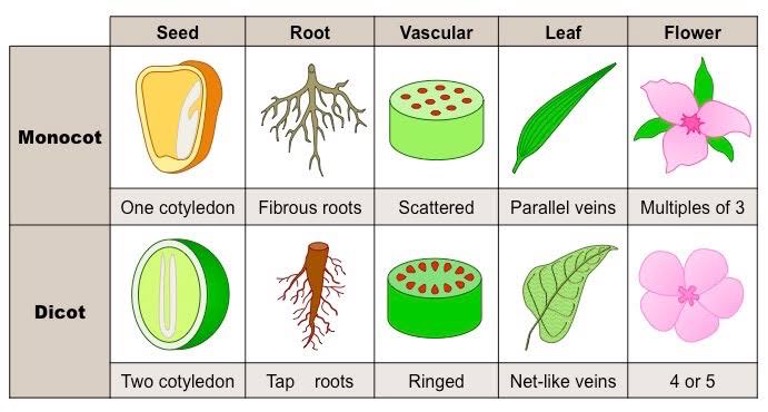
Ex. Botanical Classification of Bread Wheat (Triticum aestivum)
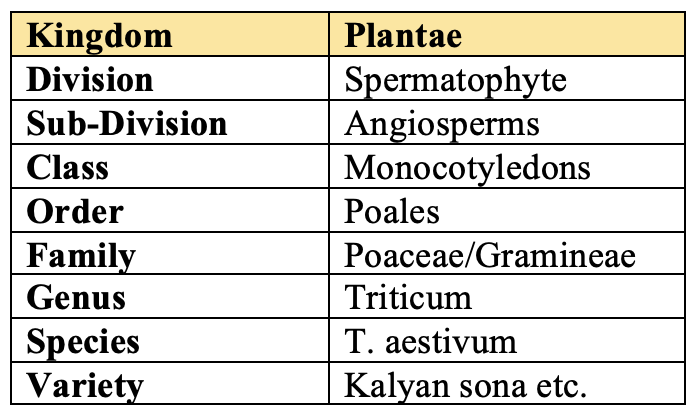
According to the botanical classification we can summarize the families of the most important crops as follows:
Monocotyledons

Dicotyledons
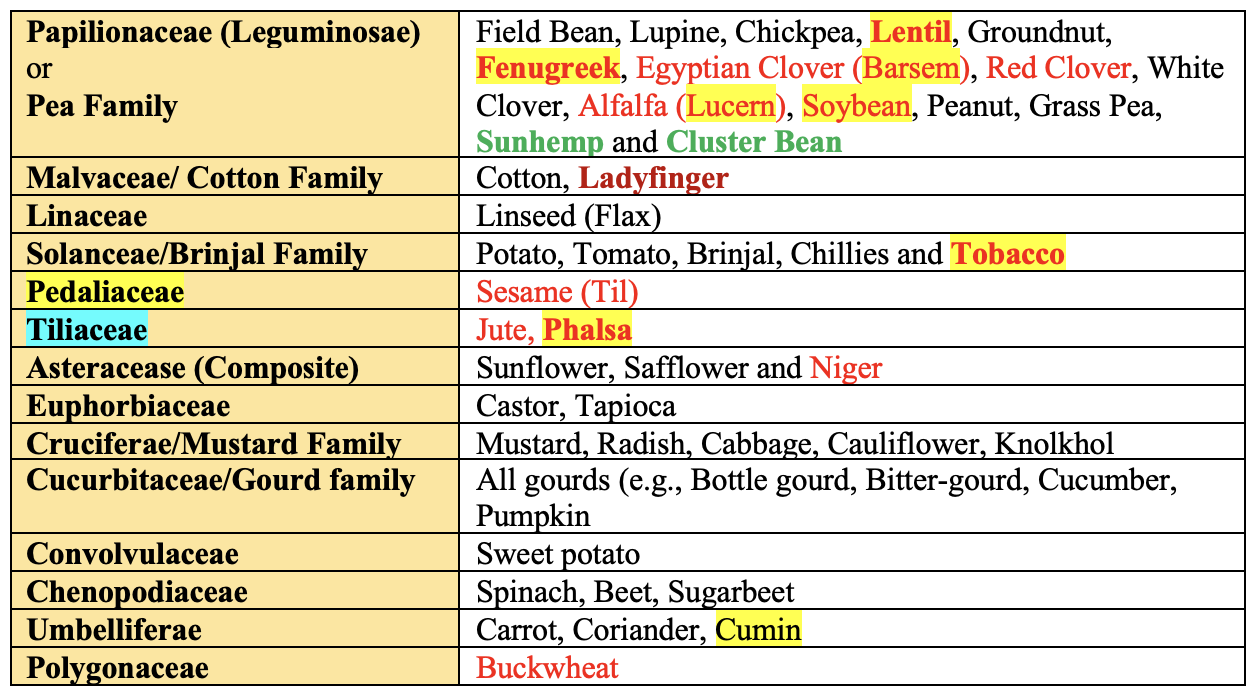
Botanical Names of Crops

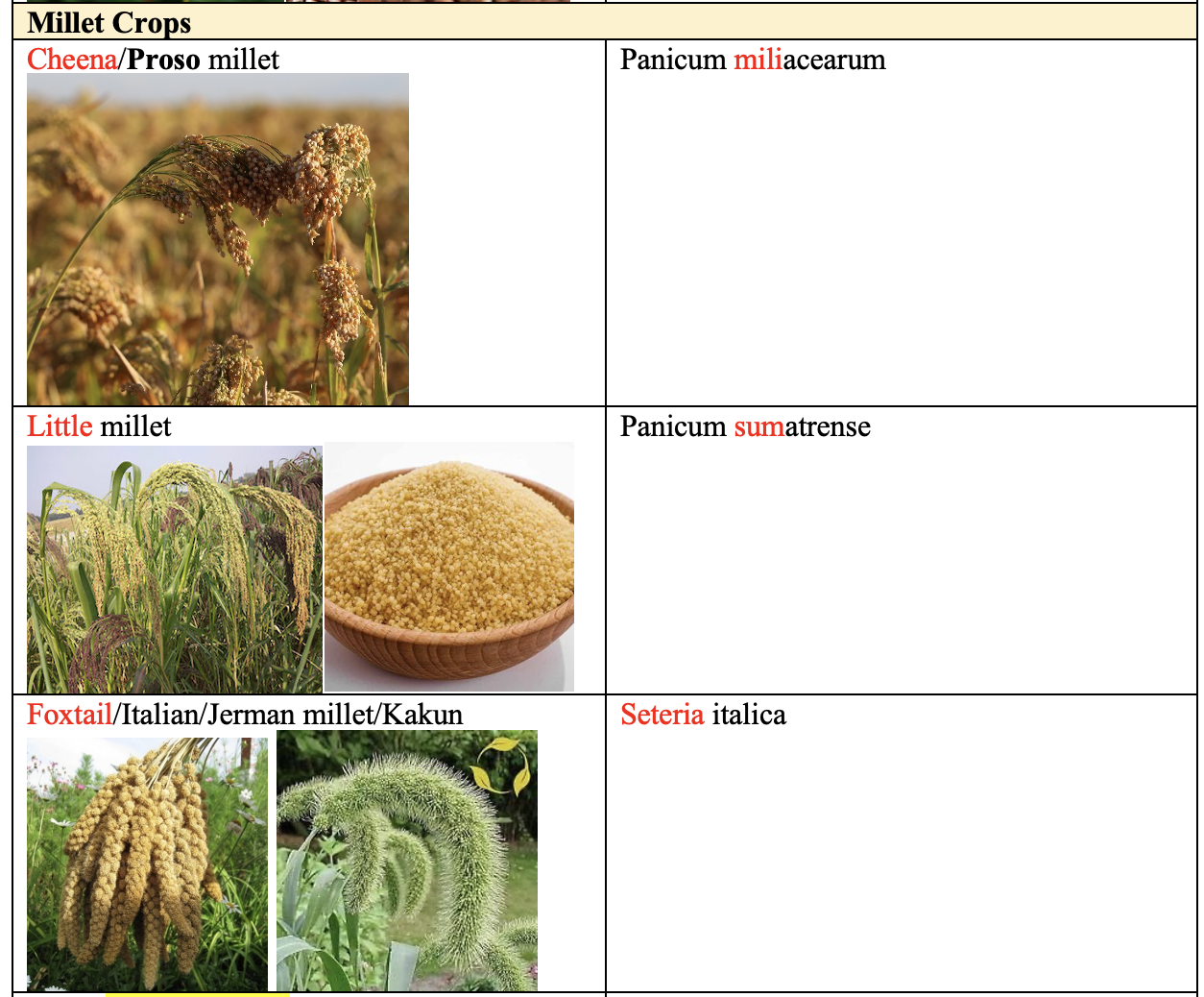
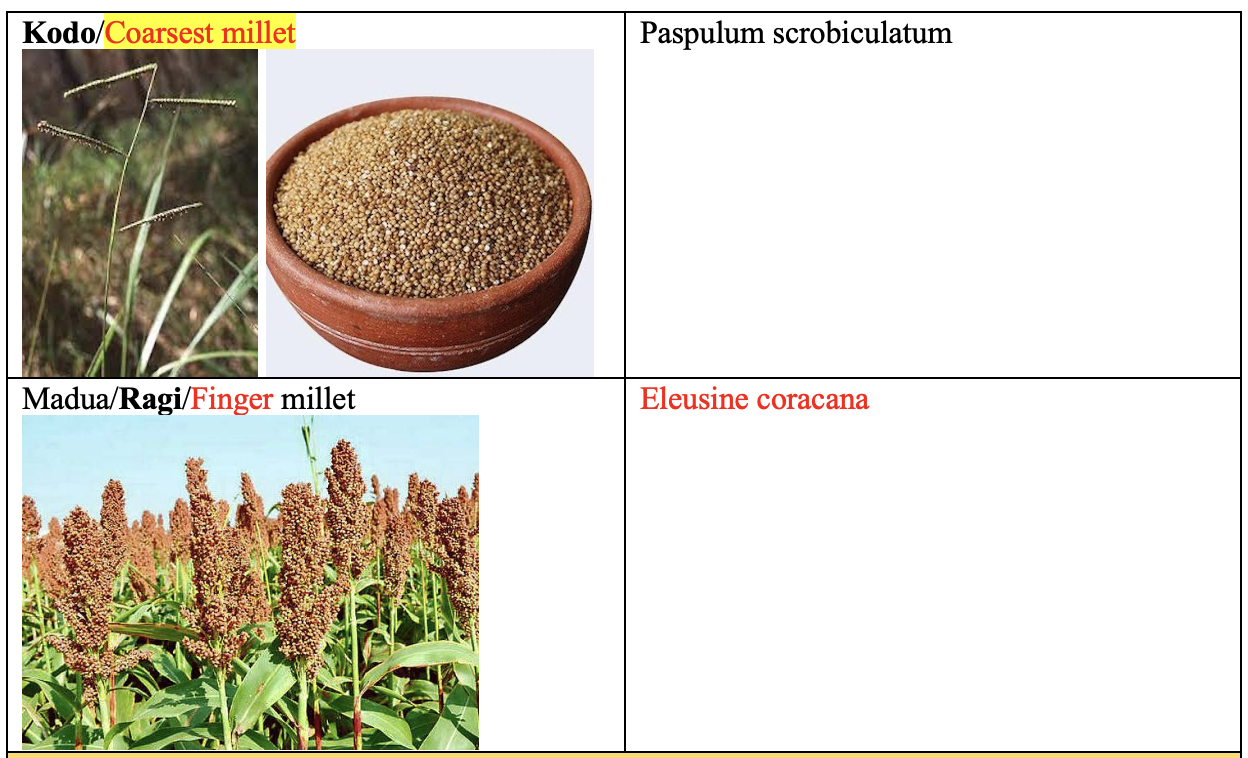
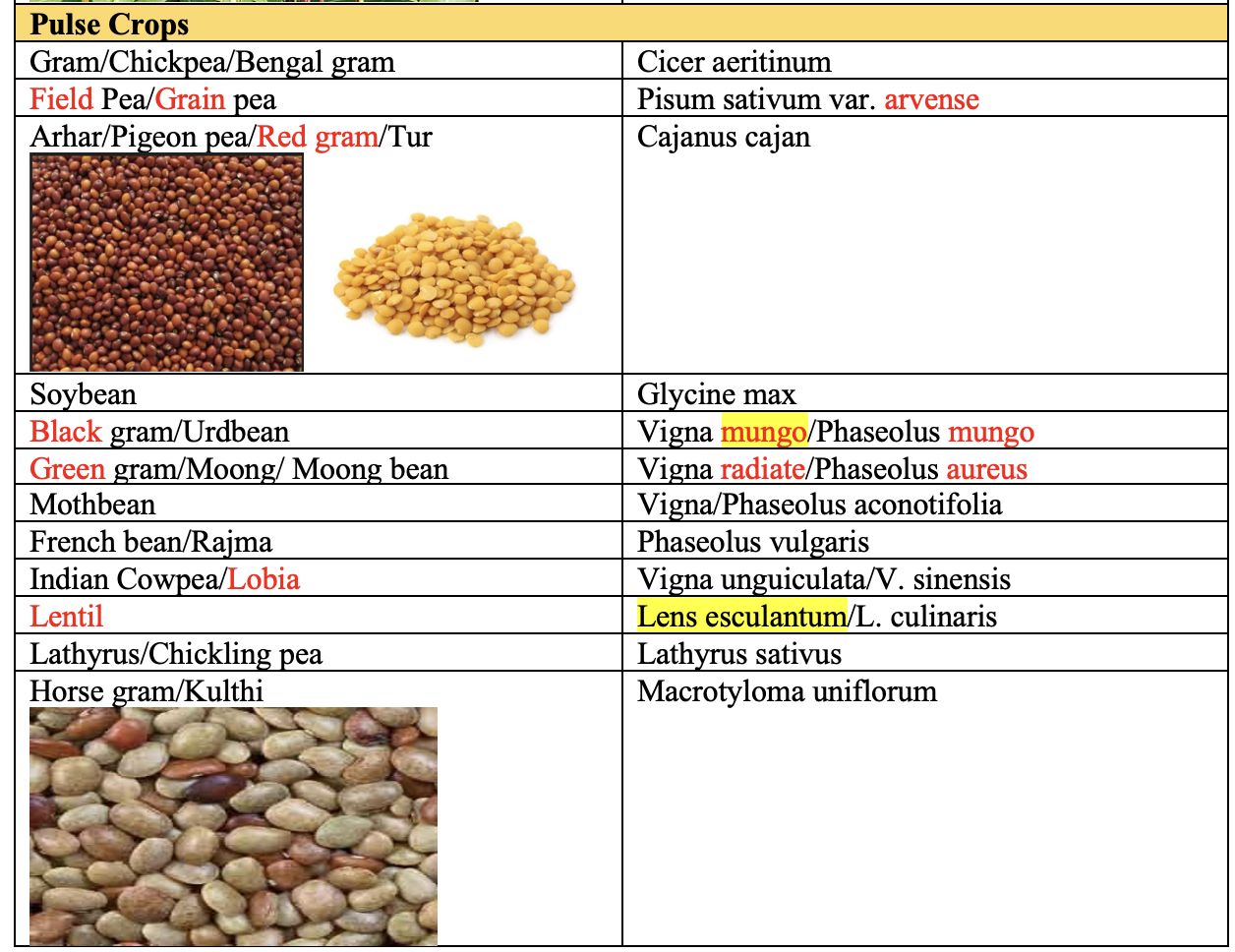



Based on Agronomic Use
Grain Crops
These are the grasses grown for their edible seeds. Examples include wheat, rice, maize, barley, oat, sorghum, millet and others.
Pulse/Legume Crops
- Pulse crops are legumes.
- The word legume is derived from the Latin word ’legere’, with means ‘to gather’.
- Pulses are important in crop rotations and crop mixtures practiced by farmers, as they help in maintaining the soil fertility.
- They are rich in protein and they meet the major share of the protein requirements of the predominantly vegetarian population of India.
- Eg. Black Gram, Green Gram etc.
Oil Seed Crops
- Crop seeds are rich in
fatty acids, are used to extract vegetable oil to meet various requirements. - E.g. Groundnut, Mustard, Sunflower, Sesamum, Linseed etc.
Fiber Crops
- These crops are specially grown to extract fiber.
- This fiber is used to make cloths, ropes, bags etc. For example, cotton, jute, flax etc.
Root and Tuber Crops
- These crops are grown for their underground economical part like rhizome, bulb, tuber and stem tubers.
- For example, onion, garlic, potato, radish, carrot and turnip.
Forage Crops
Forage crops are crops grown specifically to be grazed by livestock or conserved as hay or silage.
Spices & Condiments/Spices Crops
Products of the plants used to provide flavor and sometime color the fresh preserved food. E.g., ginger, garlic, chili, cumin, onion, coriander, cardamom, pepper, turmeric etc.
Green Manure Crop
Grown and incorporated into soil to increase fertility of soil. E.g., Sunhemp.
Based on Life Cycle (Ontogeny)
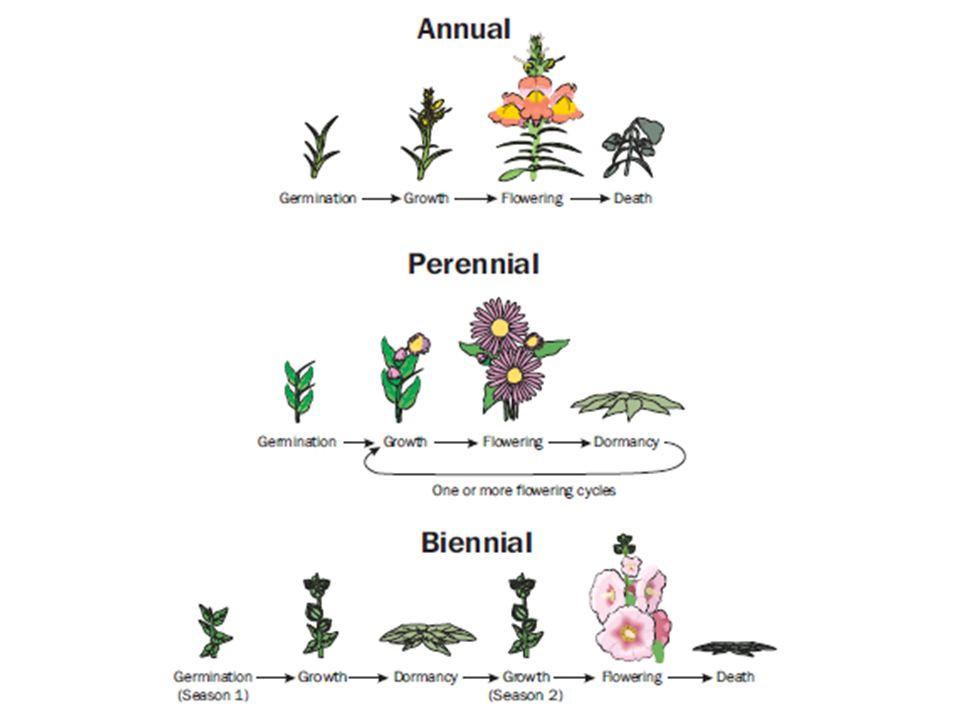
Annuals
- Plants that perform their entire life cycle from seed to flower to seed within
a single growing season. All roots, stems and leaves of the plant die annually. - Most field crops are considered annual crops such as wheat, barely, rice, maize, sorghum, lentil, check pea, lupine, flax, soybean, sesame, sunflower, safflower and others.
Biennials
- The plants require two years to complete their life cycle. The First season growth results in a small rosette of leaves near the soil surface. During the second season’s growth stem elongation, flowering and seed formation occur followed by the entire plant’s death.
- The crops of this category are
onion,sugar beetandsweet clover. If you expose sugar beet plants, grown in the first year to low temperature they can start blooming and flowering and behaved as annual crops.
Perennials
- These crops are grown in the soil for
more than two years(they can persist for more than two years). - They may either produce seed or not every year.
- In other words, they have and indefinite life period.
- They do not die after reproduction but continue to grow indefinitely from year to year.
Sugar cane,Coconut,Napier grass,alfalfa,fruit cropslike mango, guava are examples of perennial crops.
Based on Seasons
Kharif/Monsoon crops
- Sowing season: with the beginning of the first rains in June-July during the south-west monsoon season; Harvesting season: September-October
- Climate: Warm wet weather shorter day length for flowering.
- The term Kharif means
autumnin Arabic. - E.g.,
Rice,Maize,Soybean,Castor,Groundnutetc. Note: Castor is a Kharif crop but in the states of Andhra Pradesh and Odisha, it is grown as rabi crop.
Rabi/Winter Crops
- Sowing season:
October-November - Harvesting season:
March-April - Climate: Cold dry weather longer day length for flowering.
- The term Rabi means
springin Arabic. - Eg.
Wheat,barley,oats,mustard,potato,Bengal gram,Berseem,Sunflower,Safflower,Cabbage,Caulifloweretc.
Zaid/Summer Crops
- Sowing season:
February-March - Harvesting season:
May-June - Climate: Dry weather day length for flowering.
- E.g.
Black gram (Urad),Green gram (Moong),Sesame,Cowpea,Cucurbitsetc.
Based on Climate
- 🌞 Tropical Crop:
Sugarcane,Coconutetc. - ⛅️ Sub-tropical crops:
Rice,Cottonetc. - 🥶 Temperate Crops:
Wheat,Oat,Barleyetc. AFO 2017 - ❄️ Polar Crops: All pines, pasture grasses etc.
According to Root Depth
- Shallow root crops: The root system of these crops extends in the soil to a depth of
One metersuch as Wheat, Barley and Rye. - Intermediate crops: The depth of the root system of these crops ranges from
1- 1.5 meterin the case of Sugar beet. - Deep root crops: The root system of these plants extends in the soil to a depth
more than 1.5 meteras in Alfalafa.
According to Root System
Tap root system
- The main root goes deep into the soil. E.g. Gram, Cotton (
Dicots) etc.
Adventitious/Fiberous root system
- The crops whose roots are fibrous shallow & spreading into the soil. E.g. Cereal crops, Wheat, Rice (
Monocots) etc.
According to CO2 Fixation
🤔 We will dicuss about it in Plant Physiology class.
- C2
- C4
- CAM
Based on mode of Pollinations
🤔 We will dicuss about it in Plant Breeding class.
- Self-Pollinated
- Often-Cross Pollinated
- Cross-Pollinated
Restorative Crops
E.g. Legumes
Exhaustive Crops
- The crops leave the field exhaustive after growing e.g. Cereals (Rice).
Classification based on Special Purpose
Arable Crops

- Crops which are cultivated on ploughed land. They are annual crops and include cereals, root crops, tobacco, sugarcane, maize and potatoes.
Alley Crops

- Alley crops or hedge-row intercrops is grown under an agroforestry practice in which
perennial, preferablyleguminoustrees or shrubs are grown simultaneously with arable crop. IBPS 2018 - The trees, managed as hedgerows, are grown in wide rows and the crop is planted in the interspace or
alleybetween tree rows. - Slight shade tolerance and non-trailing habit are the pre-requesites of alley crop.
- Hedgerows are cut back at about one meter height at planting and kept pruned during cropping to prevent shading and to reduce competition with food crops.
- E.g.
Sweet potato,black gram,turmericandgingerare grown in the passages formed by the rows of Eucalyptus, Subabul and Cassia etc.
Augment Crops
-
Such crops are grown to supplement the yield of main crops.
-
E.g. Japanese mustard with Berseem.
-
Chineese Cabbage with mustard.
-
Here Japanese mustard and Chinese cabbage help in getting higher yield in the first cutting.

Avenue Crops
- Such crops are grown along farm roads and fences.
- E.g.
Pigeon Pea, UPPSC 2021Glyricidia,Sisaletc.
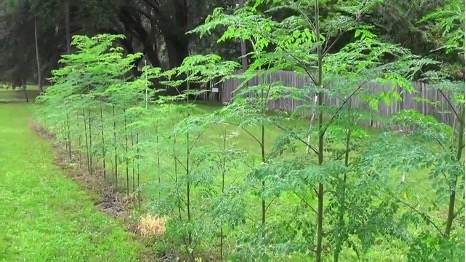
Glyricidia
Border/Barrier/Guard Crops
- Such crops protect another crop from trespassing of animals or restrict the speed of wind and are mainly grown as border.
- E.g.
Safflower(Thorny oilseed crop) is planted around the field of gram.
Brake Crops
- To break the continuity of agro-ecological situation of the field under multiple cropping systems.
- To reduce the inoculum of soil-borne harmful biotic agents such as weeds, pest and improves soil condition for crop growth e.g., Legume in rice-wheat system.
- Are also used to designate guard crops — particularly those which help to break (retard) the wind speed and protect crops from wind hazards.
Cash Crops
- A crop, such as tobacco, grown for direct sale rather than for livestock feed or a crop grown by a farmer primarily for sale to earn hard cash rather than for his or her own use.
- E.g.
Sugarcane,cotton,jute,tobaccoetc. - Also called
Commercial crops.
Catch/Contingent/Emergency Crops
- Such crops are cultivated to catch the forthcoming season when main crop is failed.
- They are of very short duration, quick growing, fast bulking, harvestable or usable at any time. e.g.,
linseed,toria,urd,moong,cowpea, etc.
Nurse Crops
- A crop of trees (nurse trees), shrubs or other plants introduced to foster or nourishment of other crops by i.e., shading it, protecting it from frost, insolation or wind. The widest use of nurse crops is in the establishment of leguminaceous plants such as alfalfa, clover.
- E.g.
Sorghum in Cowpea, Sunhemp in Sugarcane, Rai in Pea.
Complementary Crops
- Both
mainandintercropare benefited to each other. - E.g. Sorghum + Lobia (Cowpea), Sorghum receives nitrogen from Lobia and lobia requires support from Sorghum.

Competitive Crops
- Such crops compete to each other and are unsuitable for intercropping.
- E.g.
Two cereals
Supplementary Crops
- Such cops are neither complementary nor competitive.
- E.g.
Maize + Cucurbits.
Cleaning Crop
- Crops whose agronomical practices makes the field clean.
- E.g.
Potato,Maizeetc.
Cole crops:
Coleis derived from colewart. Colewart is the ancestor of wild cabbage.- Therefore, cole crops are essentially
cold weather crops🥶 belonging to the crucifereae capable for withstanding considerable frost. ❄️ - E.g.
Cabbage,CauliflowerandBrusselssprouts.
Aromatic crops:
- The crop/plant contain
odoriferousandvolatilesubstances, which occur as essential oils, gum exudates, balsam and oleoresin in one or more part of plant, viz. wood, bark, foliage, flower and fruit are called aromatic plants.
Medicinal crops:
- The crop/plant contains
alkaloids,glycosides,steroidsor other groups of compounds of medicinal value, which is used commercially, such plants are called Medicinal plants.
Energy Crop
- An energy crop is a plant grown as low cost and low maintenance harvest used to make bio-fuels, or directly exploited for its energy content.
- E.g.
Sugarcane,Potato,Maize,Tapioca. - Any fuel that is derived from biomass is called bio-fuel.
- E.g. Bio-ethanol and Bio-diesel.
Fouling Crop
- Such crops whose culture practices
allowthe infestation of weeds intensively. - E.g.
Direct seeded upland rice.
Contour Crops
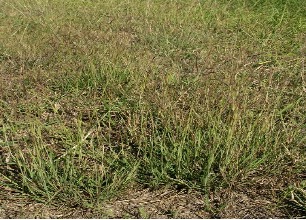
- Crops are grown on or along the contour line
to protect the land from soil erosion. - E.g.
Marvel grassetc.
Cover Crops

- A close growing crop grown primarily to improve or protect the soil from erosion through their ground covering foliage and/ or rootmats between periods of regular crop production.
- E.g. Lobia (Cowpea), groundnut, urd, sweet potato, methi etc.
Mulch Crops
- Such crops are grown to conserve the soil moisture 💧 through their ground covering foliage.
- E.g.
Cowpea.
Paira/ Utera Crops
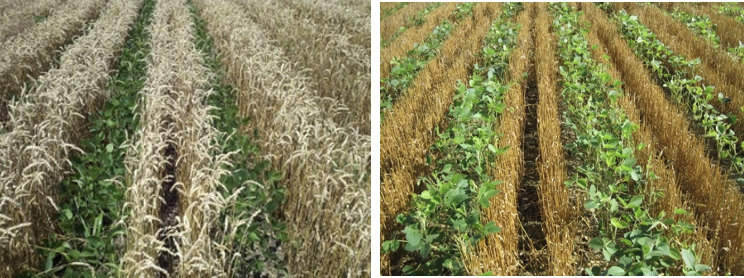
- The seed of succeeding crops like Lentil, gram, pea, lathyrus, Berseem, linseed etc. is sown broadcast at 10 to 15 days before harvesting rice crop.
- The sown crop is called paira/utera crop. This practice saves time, money (to be spent on land preparation etc.) utilizes residual moisture & fertility.
- This practice is common in both upland - lowland rice culture.
- Paira cropping in succession may constitute
relay cropping.
Paired Row Crops
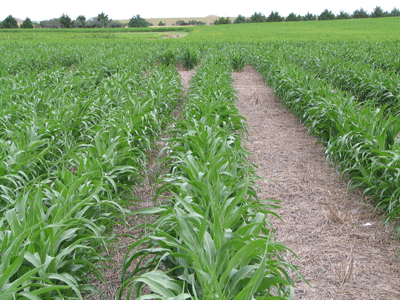
- Generally, the third row of crop is removed or growing of crop in paired row and the third row is escaped with an object
to conserve the soil moisture💧 in dryland areas.
Skip Cropping
- A line is left unsown in the regular row series of sowing is called skip cropping.
Restorative Crops
- Restorative crops are crops that help in maintaining the fertility of soil.
- E.g.
Pulses and legumes.
Riparian Crops

- Grown along irrigation and drainage channels or water bodies.
- E.g. Water bind weed (kalmi sak), Para grass.
- They help to protect the soil from erosion.
Silage Crops

- Such crops like
corn,legumes, andgrassesthat have been harvested at early maturity, finely chopped, packed tightly to exclude air, and stored in tower silos, pits, or trenches for properlyfermentationwhich is used as animal feed during lean period or off season. - E.g.
Maize,Cowpea,Sorghumetc.
⭐️ Ensiling: The process of making silage is called ensiling.
Ley Crops

- Any crop or combination of crop is grown for grazing or harvesting for immediate or future feeding to livestock.
- Growing
leguminous pasturewithgrain cropsis known as lay farming. RRB SO 2020 - E.g.
Berseem + Mustard.
Soiling Crops
- Grown to harvest while they are
still green and fed fresh 🫐 to livestock 🐄in stalls. - E.g.
Berseem,Napieretc. - These crops are not processed for any addition and fed to the animals in green form immediately after cutting.
- Maize, Oat, Peas and Sorghum are good examples of Soiling crops.
Smother crops:

- Smother crops are specialized cover crops being ability to suppress weeds by providing dense foliage and quick growing ability.
- E.g.
Cowpea,Urd,Buckwheat,Mustardetc.
Stimulate Crops
- Stimulate crops stimulate the human body.
- E.g.
tobacco,opiumetc.
Trap/Decoy Crops
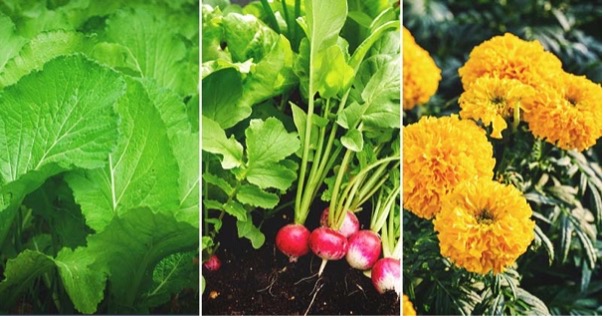
- Trap crops are grown to protect the main cash crop from a certain pest or several pests. These crops are planted in completely surrounding the main cash crop and prevent pest attack from all sides of the field through attracting the pests.
- E.g. Cotton red bug trapped by
ladyfingeraroundcotton.Orobanche(weed) is trapped bySolanaceousplants andStrigabySorghum.
Truck Crops

- Growing one or more vegetable crops on a
large-scaleform fresh shipment to distant markets. - Most important truck crops are
potato,tomatoes,lettuce,melons,beets,broccoli,celery,radishes,onions,cabbage, andstrawberries.
Ware Crops
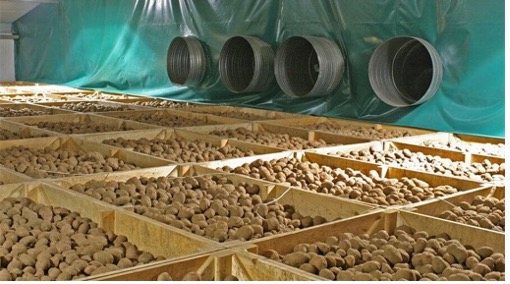
- Such crops are grown for temporary storing as intact in
warehousefor future use or sale. - E.g. Potato UPPSC 2021
Crop
- “A group of cultivated plants those are grown commercially on a large scale”.
- Cultivated plants or agriculture produce, such as grain, vegetables, or fruit, considered as a group.
- The basic principles of crop production are the ways and means for the better management of soil, plants and environments to obtain ecologically maximum returns per unit area for years.
Crops Classification
💡 Why crop classification is important?
- To get acquainted with crops
- To know the growing season of the crop
- To understand the requirement of soil and water of different crops
- To know the adaptability of crops
- To know the growing habit of crops
- To know the economic produce of the crop plant and its use
- Overall to know the actual condition required for the cultivation of the plant
Basis for Classifying …
Become Successful With AgriDots
Learn the essential skills for getting a seat in the Exam with
🦄 You are a pro member!
Only use this page if purchasing a gift or enterprise account
Plan
- Unlimited access to PRO courses
- Quizzes with hand-picked meme prizes
- Invite to private Discord chat
- Free Sticker emailed
Lifetime
- All PRO-tier benefits
- Single payment, lifetime access
- 4,200 bonus xp points
- Next Level
T-shirt shipped worldwide

Yo! You just found a 20% discount using 👉 EASTEREGG

High-quality fitted cotton shirt produced by Next Level Apparel